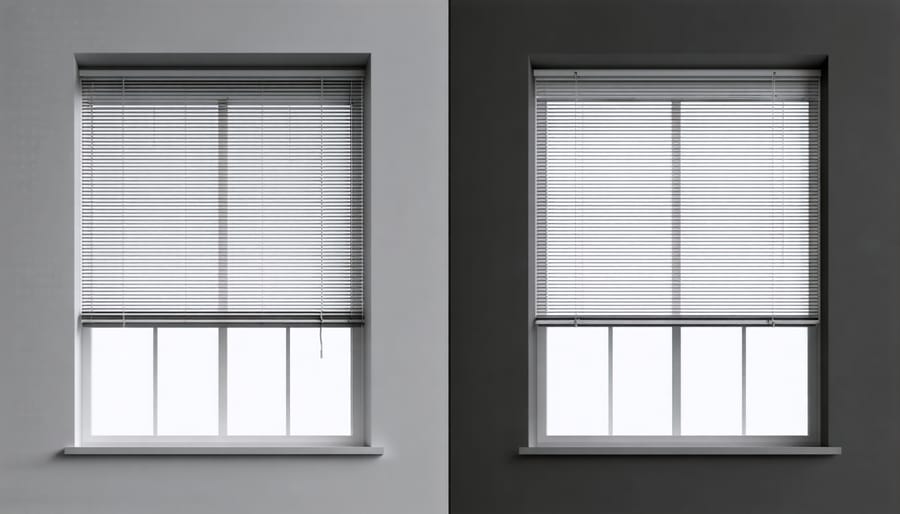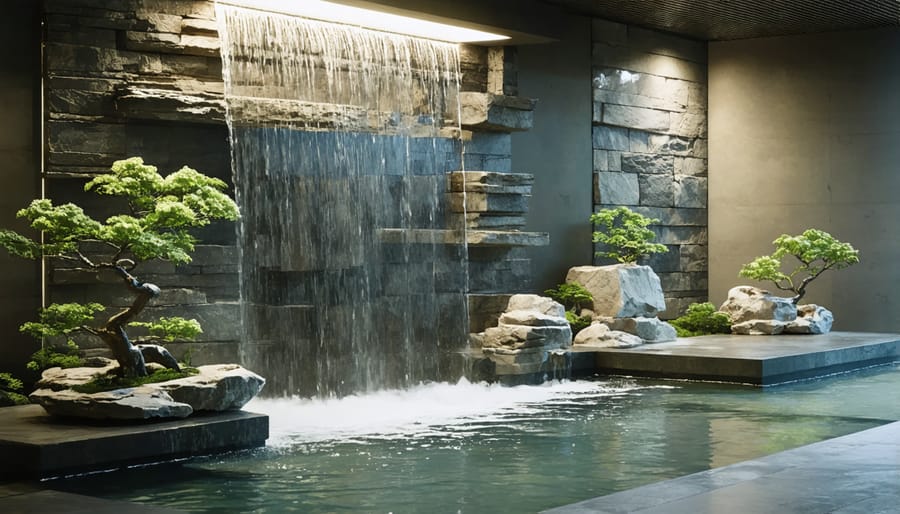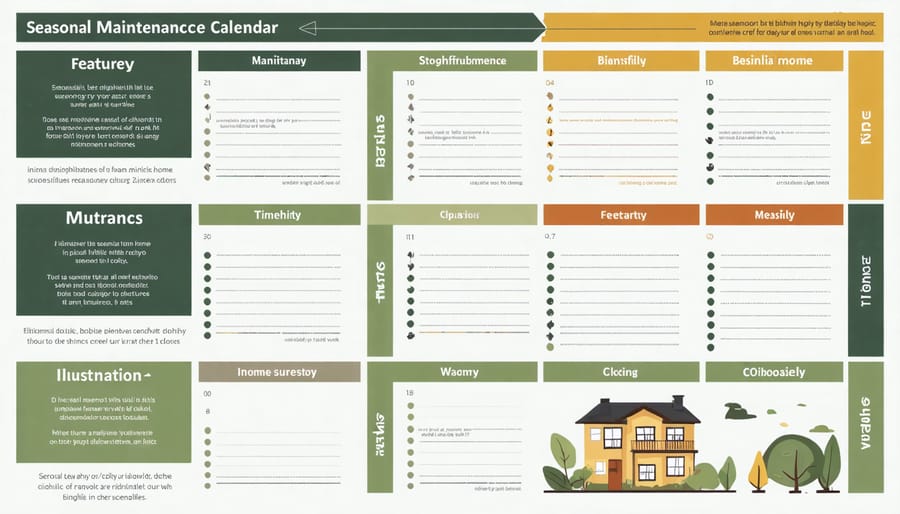Transform your home into a climate-resilient sanctuary by implementing biophilic design principles that work with nature, not against it. Install green roofs and living walls to naturally regulate indoor temperatures while creating oxygen-rich spaces. Design water-smart landscapes with native, drought-resistant plants that thrive in your local climate while reducing water consumption by up to 50%. Position trees and climbing vegetation on south-facing walls to provide natural cooling in summer and insulation in winter, cutting energy costs by 20-30%. These practical adaptations not only protect your home from extreme weather but also create a harmonious living space that connects you with nature.
Our changing climate demands smarter, more sustainable home design solutions. By combining traditional wisdom with modern innovation, you can create a home that’s not just beautiful and comfortable, but also resilient to whatever weather patterns emerge. From rain gardens that manage stormwater to passive solar design that reduces energy dependency, these adaptation strategies work together to protect your investment while enhancing your daily living experience.
Natural Cooling Solutions That Slash Energy Bills
Strategic Plant Placement for Temperature Control
Strategic plant placement can transform your home into a naturally cooled sanctuary while reducing your energy costs. Think of your windows as nature’s air conditioning units – placing tall, leafy plants near sun-facing windows creates a living shield that blocks excess heat while still allowing natural light to filter through.
For maximum cooling effect outdoors, position deciduous trees or large shrubs on the southern and western sides of your home. During summer, their dense foliage provides shade and natural cooling, while in winter, bare branches allow warming sunlight to reach your walls and windows.
Inside, group plants with high moisture content in areas where you spend the most time. Plants like peace lilies, snake plants, and Boston ferns naturally release water vapor through transpiration, creating a cooling effect similar to a small humidifier. Place these green helpers in your home office, living room, or bedroom for the best results.
Create a “green curtain” effect by installing climbing plants on trellises near windows or setting up hanging plants in tiered arrangements. This vertical gardening approach maximizes cooling benefits while saving valuable floor space.
Pro tip: Place small potted plants near air vents or fans to help distribute their cooling effects throughout your space. Just remember to keep them far enough away to prevent any water drainage issues or airflow obstruction.
Living Walls and Green Screens
Living walls and green screens are becoming increasingly popular as natural climate control solutions for modern homes. These vertical gardens not only create stunning living wall designs but also act as natural insulators, helping regulate indoor temperatures throughout the year.
The plants in these systems create a buffer zone between your home’s exterior and interior, reducing heat gain in summer and providing additional insulation during winter months. When strategically placed on sun-facing walls, living walls can reduce cooling costs by up to 23% during hot seasons.
To get started with your own living wall, consider low-maintenance plants like sedums, ferns, and small shrubs. These hardy varieties adapt well to vertical growing conditions and require minimal care. You’ll need a proper irrigation system, usually incorporating drip lines, and a sturdy framework to support the plant structure.
For renters or those seeking a simpler solution, moveable green screens offer similar benefits with added flexibility. These can be positioned wherever needed and typically feature climbing plants like ivy or jasmine on lightweight trellises.
Remember to check your wall’s structural integrity before installation and ensure proper waterproofing measures are in place. Starting small with a test area can help you understand the maintenance requirements before expanding to larger installations.

Weather-Smart Window Treatments
Climate-Responsive Curtains and Blinds
Smart window coverings are your secret weapon in creating a climate-adaptive home that responds to changing weather conditions throughout the year. By selecting the right curtains and blinds, you can significantly reduce your energy costs while maintaining a comfortable indoor environment.
For summer cooling, opt for light-colored, reflective curtains that bounce heat away from your windows. Cellular or honeycomb shades are particularly effective, as their unique design creates air pockets that act as natural insulators. Installing these on south and west-facing windows can reduce heat gain by up to 45% during peak summer hours.
In winter, heavy thermal curtains or Roman shades provide an extra barrier against cold drafts. Look for options with thermal backing or consider doubling up with sheer curtains and heavier drapes for flexible control over light and temperature. Installing curtains close to windows and extending them to the floor maximizes their insulating properties.
Automated systems take climate responsiveness to the next level. Smart blinds can be programmed to adjust throughout the day based on sun position and temperature readings, ensuring optimal comfort without constant manual adjustment. Many systems can even be controlled through your smartphone, making it easy to manage your home’s climate while you’re away.
For best results, combine different types of window coverings based on room orientation and usage. South-facing rooms might benefit from adjustable venetian blinds, while bedrooms could use blackout curtains with thermal properties.

Natural Ventilation Optimization
Creating a well-ventilated home starts with understanding how air naturally flows through your space. By strategically placing windows and optimizing their use, you can create refreshing cross-breezes that keep your home comfortable while reducing your reliance on air conditioning.
Start by identifying your home’s prevailing wind direction and placing operable windows on opposite sides of rooms. This creates a natural pathway for air movement, with warm air exiting through higher windows while cooler air enters through lower ones. For maximum effectiveness, ensure your windows are positioned at different heights to take advantage of the stack effect – warm air’s natural tendency to rise.
Consider installing casement windows that can be angled to catch and direct breezes into your home. Double-hung windows offer excellent ventilation control, allowing you to open them from both top and bottom to regulate airflow. For rooms with only one exterior wall, try adding clerestory windows or skylights to create vertical air circulation.
Don’t forget about transitional spaces like hallways and staircases. These areas can act as natural ventilation corridors when properly designed with windows at both ends. Adding window screens allows you to keep windows open longer while keeping insects out.
Remember to maintain clear paths between windows – arrange furniture and décor to avoid blocking airflow. During cooler months, you can adjust your window usage to minimize heat loss while still maintaining healthy air circulation through periodic ventilation.
Water-Wise Interior Features
Indoor Water Features for Humidity Control
Indoor water features offer a beautiful and effective way to regulate humidity while adding a touch of tranquility to your living spaces. These elements, when combined with natural materials, create a harmonious environment that helps maintain optimal moisture levels throughout the year.
Consider installing a wall-mounted fountain in your living room or entryway. These features not only serve as striking focal points but also release fine water droplets into the air, naturally increasing humidity during dry seasons. For smaller spaces, tabletop fountains or decorative water bowls can achieve similar results while taking up minimal space.
One clever approach is to position water features near air vents or in areas with good air circulation. This strategic placement helps distribute moisture more evenly throughout your home. During winter months, when indoor heating can create uncomfortably dry conditions, these water elements become particularly valuable for maintaining healthy humidity levels.
To maximize effectiveness, opt for features with adjustable flow rates, allowing you to control humidity output based on seasonal needs. Remember to use filtered water and clean your features regularly to prevent mineral buildup and ensure healthy air quality.
Pro tip: Add small plants around your water feature to create a mini ecosystem that enhances both humidity control and air purification. This combination creates a natural climate control system that’s both functional and visually appealing.

Drought-Resistant Plant Selection
Choosing drought-resistant indoor plants is a smart way to create a sustainable, climate-adapted home while keeping your space beautifully green. These resilient plants not only conserve water but also thrive with minimal maintenance, making them perfect for busy households.
Consider starting with the elegant Snake Plant (Sansevieria), which stores water in its thick leaves and can go weeks without watering. ZZ Plants (Zamioculcas zamiifolia) are equally impressive survivors, featuring glossy leaves and an ability to withstand long periods of drought.
For a more sculptural look, various types of succulents and cacti make excellent choices. Jade Plants offer a tree-like appearance and store water efficiently, while Aloe Vera doubles as both a drought-resistant plant and a practical healing herb for your home.
Don’t overlook the striking Chinese Evergreen (Aglaonema), which adapts well to low-light conditions while requiring minimal water. The Cast Iron Plant (Aspidistra elatior) lives up to its name with incredible durability and drought tolerance.
Expert Tip: Group these water-wise plants together to create a microclimate that maintains humidity naturally. Place them in well-draining pots with appropriate soil mixtures, and remember that most drought-resistant plants prefer to dry out completely between waterings.
These hardy plants not only help conserve water but also add a touch of low-maintenance greenery to your living space, making them perfect choices for climate-conscious home decor.
Natural Material Choices for Climate Resilience
Temperature-Regulating Materials
Choosing the right materials for your home can make a significant difference in maintaining comfortable temperatures year-round. Start with your walls by considering materials like phase-change drywall, which absorbs and releases heat as needed. For insulation, opt for natural materials like sheep’s wool or cellulose, which offer excellent temperature regulation while being eco-friendly.
Windows play a crucial role in temperature control. Consider installing low-emissivity (low-e) glass or adding ceramic window films that reflect heat while allowing natural light in. For exterior surfaces, light-colored materials with high solar reflectance can significantly reduce heat absorption during summer months.
Don’t forget about flooring! Materials like cork and bamboo naturally regulate temperature and feel comfortable underfoot throughout the year. In your roof space, consider installing cool roofing materials or green roofing systems that provide natural insulation.
To maximize the effectiveness of these materials, regular cooling system maintenance is essential. Create a seasonal maintenance schedule to ensure all your temperature-regulating materials are working at their best. Remember, the key is to choose materials that work together as a system, creating a comfortable indoor environment while reducing your energy consumption.
Moisture-Managing Surfaces
Managing indoor humidity is crucial for both comfort and health, and the right surfaces can make a world of difference. Natural materials like clay plaster and lime-based finishes are excellent at regulating moisture levels, acting like a natural dehumidifier for your space. These materials absorb excess moisture when humidity is high and release it back when the air becomes too dry.
Cork and wood panels are also fantastic options for moisture management. Beyond their aesthetic appeal, these materials have natural properties that help maintain balanced humidity levels. Cork, in particular, resists mold growth while regulating moisture, making it perfect for areas prone to dampness.
For more modern solutions, consider moisture-smart drywall or gypsum boards specifically designed with humidity control in mind. These materials contain special additives that enhance their moisture-managing capabilities without compromising their durability.
Pro tip: Layer your moisture management strategy by combining these surfaces with proper ventilation. For instance, install clay plaster in your bathroom along with adequate ventilation to create an effective moisture-control system. You can also enhance these surfaces’ effectiveness by positioning them strategically in areas where humidity tends to fluctuate, such as kitchens and bathrooms.
Remember to maintain these surfaces properly – regular cleaning and occasional resealing (for wood and cork) will help them continue performing their moisture-managing function effectively for years to come.
Smart Maintenance for Lasting Results
Seasonal Adjustment Guide
Just like nature adapts to changing seasons, your biophilic elements need seasonal adjustments to thrive year-round. In spring, welcome more natural light by cleaning windows and trimming outdoor plants that might block sunlight. Add seasonal flowers and sprouting plants to bring the awakening energy indoors.
Summer calls for strategic placement of plants to provide natural cooling. Position leafy plants near windows to filter harsh sunlight and reduce heat gain. Consider rotating your indoor garden to protect sensitive plants from intense afternoon sun. Use lightweight, natural fabrics for curtains and swap out heavier textiles for breathable options.
As autumn approaches, bring in warm-toned plants and dried botanical elements. Add cozy natural textures like wool and wood, and rearrange plants to maximize dwindling natural light. Consider introducing plants that thrive in lower light conditions.
Winter requires the most attention to maintain your biophilic connection. Move plants away from cold windows and drafts, and use grow lights if necessary. Incorporate evergreen elements and winter-blooming species to maintain life and color. Add natural elements like pinecones and branches to remind you of nature’s presence even when it’s dormant outside.
Remember to adjust watering schedules and humidity levels with each season, and always monitor your plants for signs of stress during seasonal transitions.

Long-term Care Strategies
Maintaining your climate adaptation features isn’t a one-and-done task – it’s an ongoing commitment that ensures your home stays resilient year after year. Start by creating a seasonal maintenance checklist for your climate-adapted features. In spring and fall, inspect green roofs for proper drainage and remove any debris that might block water flow. Check living walls for signs of pest infestation or disease, and trim back overgrown plants that might affect ventilation.
For passive cooling systems, clean air vents and replace filters regularly. If you’ve installed solar shading devices, give them a thorough cleaning every few months to maintain their effectiveness. Natural ventilation systems need periodic checks to ensure all components are working smoothly – lubricate moving parts and clear any obstructions from vents.
Water management systems require special attention. Clean rain barrels and check for leaks before the rainy season begins. Maintain permeable pavements by regularly removing sediment and debris that could clog the surface. For drought-resistant landscaping, evaluate your irrigation system annually and adjust watering schedules based on seasonal changes.
Document all maintenance activities and keep records of any repairs or replacements. This history helps you track performance patterns and anticipate future needs. Consider setting up automatic reminders for routine maintenance tasks – many smart home systems can help you stay on top of these responsibilities.
Remember, investing time in maintenance now prevents costly repairs later and ensures your climate adaptation features continue protecting your home effectively for years to come.
As we’ve explored throughout this guide, adapting our homes to climate change doesn’t mean sacrificing beauty or comfort – quite the opposite! By implementing these nature-inspired strategies, you’re not just creating a more resilient living space; you’re crafting a harmonious environment that works with nature rather than against it.
Remember, you don’t need to tackle everything at once. Start with simple changes like adding shade-providing plants or installing a rain garden. As you become more comfortable, you can gradually incorporate more advanced adaptations such as green roofs or comprehensive water management systems.
The key is to choose solutions that make sense for your specific climate, budget, and lifestyle. Whether you’re dealing with increasing heat waves, frequent storms, or drought conditions, there’s a natural solution waiting to be discovered.
By taking action now, you’re not just preparing for the future – you’re creating a more enjoyable, sustainable home today. Your efforts contribute to both personal comfort and the broader fight against climate change. Plus, many of these adaptations can increase your property value while reducing utility costs.
Take the first step today. Choose one strategy that resonates with you and start there. Nature has already provided us with the blueprint – all we need to do is follow its lead and adapt these time-tested solutions to our modern homes.
